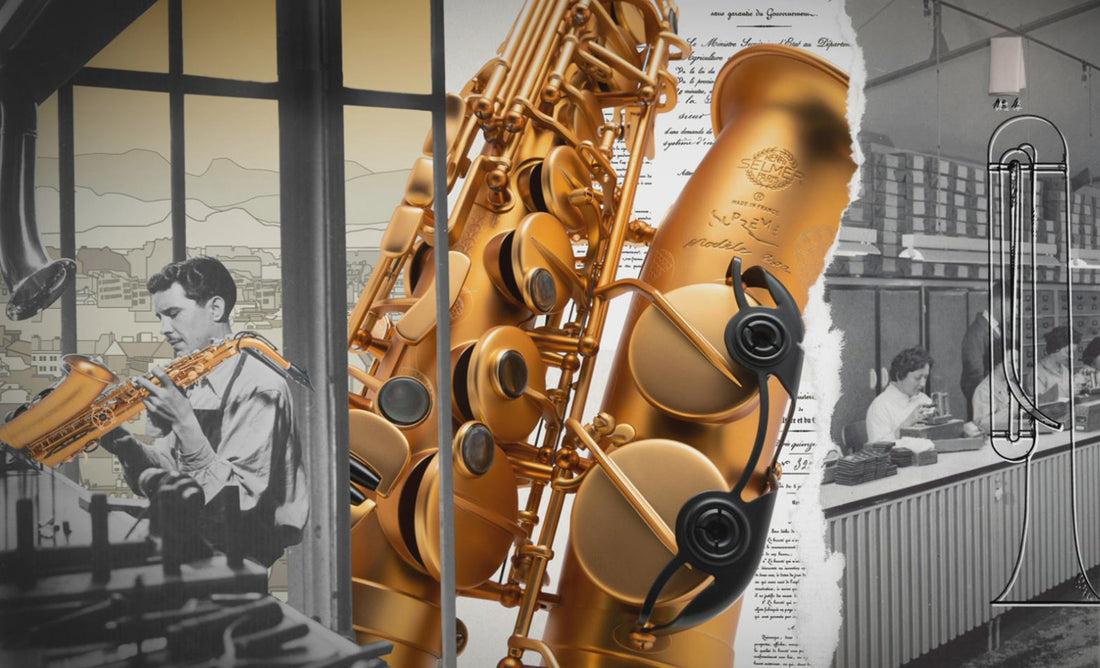The Supreme “Modèle 2022”, a tribute to History

Maison SELMER and the History of music
Henri SELMER Paris entered the history of the saxophone by presenting its first model in 1922, the “Series 22”, renamed “Modèle 22”. The brand has become a worldwide and historical reference, and has given birth to mythical models such as the Balanced Action, which laid the foundations of the modern saxophone, or the Mark VI, a legendary instrument widely acclaimed and adopted by the greatest.
From the outset, the company has worked hand-in-hand with musicians, drawing on their expertise to design, innovate and improve its line of instruments. Over the years, the company has contributed to the history of music, particularly jazz, by equipping the best instrumentalists: Benny Carter, Coleman Hawkins, John Coltrane, Stan Getz, Dexter Gordon, Ornette Coleman, Joe Henderson, Sonny Rollins, Benny Golson…

Last year, Henri SELMER Paris redefined the identity of the alto saxophone by releasing the Supreme, an instrument with the qualities of all the models that preceded it, embodying the culmination of a century-old know-how.
In 2022, to celebrate 100 years of history and music, we have decided to adorn the Supreme with a new design for a limited edition of 641 instruments. This collector's model, the Modèle 2022, celebrates the artistic richness of the 20th century, and of course the saxophone, which patiently waited until the 1920s to fully blossom through different repertoires.
An animated film as a tribute
This clip was imagined by Henri SELMER Paris and Yamoy (Graphic design agency). It celebrates the artistic and creative bubbling of the 1920s - which saw the birth of the first SELMER saxophone - and the rich musical history of the last century.
Mixing illustrations, photomontages and various typographies, the film goes through several graphic styles in order to best illustrate the different eras.
The curtain opens on Paris at the end of the 19th century. We witness the construction of the Eiffel Tower (1887-1889), at the time when Henri Selmer founded the company. Symbol of Paris and more generally of France, the Eiffel Tower is also the symbol of an era. Built for the World's Fair, the monument was also used for scientific experiments, notably for telephone, telegraph and radio links. If the tower was intented to be dismantled after 20 years, it is finally its function of radio antenna that saved it. It played a strategic role during the First World War and in the 1920s it was put to civilian use: radio programs were regularly broadcast from the Eiffel Tower, thus participating in the rise of jazz and the saxophone…

We then arrive at Place Dancourt, where the SELMER workshops were located at the time, close to Montmartre. There are posters featuring several personalities:
- Elise Hall : American saxophonist and patron of the arts born in Paris, she commissioned numerous works from renowned composers to enrich the saxophone repertoire at the beginning of the 20th century: Claude Debussy (Rhapsodie), Vincent d'Indy (Choral varié), Charles Loeffler (Divertissement espagnol), Florent Schmitt (Légende)...
- Joséphine Baker : after having made her debut in the Music-Hall in New York, the artist settled in Paris in the 1920s and became an icon of the Roaring Twenties. A dancer, singer and showgirl, she contributed to the enthusiasm of Parisians for jazz, before becoming involved in the Resistance and the civil rights movement.
- Marcel Mule : soloist in the Garde Républicaine, teacher at the Paris Conservatory and then tester at Henri SELMER Paris, Marcel Mule is considered the father of the French classical saxophone school. He introduced the instrument into the classical sphere and ensured its international influence.
A poster for a jazz festival also mentions Sonny Rollins, John Coltrane, Wayne Shorter and Ornette Coleman, who are among the most influential saxophonists in jazz history.
Around the corner, Alexandre Selmer presents the “Modèle 22”. Younger brother of Henri and also a clarinetist, Alexandre emigrated to the United States at the end of the 20th century to play in the Boston and Philadelphia Symphony Orchestras. He contributed to making SELMER instruments known on the continent.
The 1920s were also the era of Art Déco. This artistic movement was opposed to the volutes of Art Nouveau and marked a return to symmetrical patterns and clean lines.

It is in this Art Déco style that a representation of the emblematic photo "A Great Day in Harlem" is drawn. In 1958, on a commission from Esquire magazine, photographer Art Kane gathered 57 of the greatest jazz musicians of the time for an issue dedicated to the Golden Age of Jazz. Amused by the exercise and the idea of being together, the musicians arrived at the meeting place, more or less on time, they chatted, laughed, Count Basie sat on the sidewalk, children from the neighborhood joined him… The moment is captured. The photo went around the world.

The clip goes on to evoke some of the most acclaimed albums in jazz history: Sonny Rollins' Saxophone Colossus (1956), a masterpiece awarded an outstanding "Crown" by The Penguin Guide to Jazz; Benny Golson and the Philadelphians (1958) ; and John Coltrane's A Love Supreme (1964), a mythical 33-minute work recorded in a single session.
The video could not end without a nod to Manu Dibango, our "papy groove", who passed away two years ago. Legend of afro-jazz but not only, the saxophonist knew how to gather and spread his music beyond the divisions…
The musical evolution during the 20th century is also illustrated by the interpretation of the piece Smile (Charlie Chaplin) by Pierrick Pédron. Throughout the piece, the saxophonist borrows from different musical aesthetics in order to accompany us in this journey through history…
► Discover the Supreme “Modèle 2022”
► Learn more about Henri SELMER Paris History